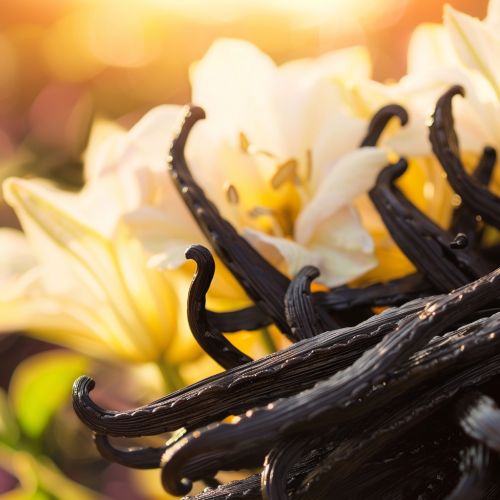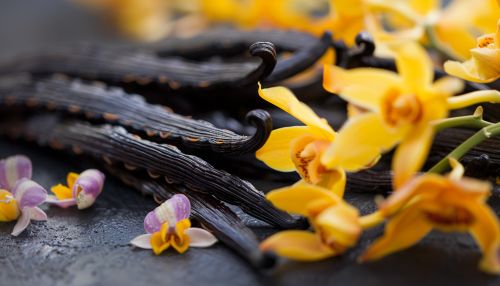Vanilla
Introduction
Vanilla is a flavoring derived from orchids of the genus Vanilla, primarily obtained from pods of the Mexican species, flat-leaved vanilla (V. planifolia). The word vanilla, derived from the Spanish word "vainilla," means "little pod." Vanilla is the second most expensive spice after saffron due to the labor-intensive process of growing and harvesting the vanilla pods. Despite its high cost, vanilla is widely used in both commercial and domestic baking, perfume manufacturing, and aromatherapy.
History
The history of vanilla dates back to pre-Columbian Mesoamerica, where the Totonac people of the Gulf Coast of Mexico were the first to cultivate vanilla. After the Aztecs conquered the Totonacs, they adopted the use of vanilla and combined it with their chocolate drink, Xocolatl. When Spanish conquistador Hernán Cortés arrived in the Americas, he brought vanilla back to Europe, where it quickly gained popularity.
Botany
Vanilla is a member of the Orchidaceae family, and it is the only orchid that produces an edible fruit. The vanilla orchid is a perennial climbing vine that can grow up to 30 meters long. It has green, fleshy stems and leaves, and it produces large, fragrant flowers that are typically yellow-green in color. The flowers bloom for only one day and must be pollinated within 12 hours to produce a pod. In the wild, vanilla is pollinated by specific species of bees and hummingbirds, but in commercial cultivation, hand-pollination is necessary.
Cultivation
Vanilla cultivation is a labor-intensive process that requires a tropical climate with high humidity and temperatures ranging from 21 to 32 degrees Celsius. The primary regions for vanilla cultivation are Madagascar, Indonesia, Mexico, and Tahiti. The process begins with the planting of vanilla cuttings, which take about three years to mature and produce flowers. Each flower must be hand-pollinated, and the resulting pods take six to nine months to mature. After harvesting, the pods undergo a curing process that includes blanching, sweating, drying, and conditioning, which can take several months.
Processing
The processing of vanilla beans is a meticulous and time-consuming process. After harvesting, the beans are blanched in hot water to stop their growth. They are then placed in the sun to sweat, which helps to develop the characteristic vanilla flavor. The beans are then dried in the sun for several weeks until they reach the desired moisture content. Finally, the beans are conditioned by storing them in a cool, dark place for several months to allow the flavor to fully develop.
Chemical Composition
The primary chemical component of vanilla is vanillin, which is responsible for its characteristic aroma and flavor. In addition to vanillin, vanilla beans contain over 200 other compounds, including p-hydroxybenzaldehyde, vanillic acid, and various phenolic compounds. These compounds contribute to the complexity of vanilla's flavor profile. The concentration of vanillin and other compounds can vary depending on the species of vanilla, the region of cultivation, and the processing methods used.
Uses
Vanilla is used in a wide range of products, including food and beverages, perfumes, and aromatherapy. In the culinary world, vanilla is a popular flavoring for baked goods, desserts, and beverages. It is also used as a flavor enhancer in savory dishes. In the perfume industry, vanilla is valued for its warm, sweet aroma and is used as a base note in many fragrances. In aromatherapy, vanilla is believed to have calming and relaxing properties.
Economic Importance
Vanilla is a highly valuable commodity, with the global vanilla market estimated to be worth several hundred million dollars. Madagascar is the largest producer of vanilla, accounting for approximately 80% of the world's supply. The high cost of vanilla is due to the labor-intensive cultivation and processing methods, as well as the risks associated with climate change, natural disasters, and market fluctuations. Despite these challenges, vanilla remains a sought-after ingredient in various industries.
Challenges in Vanilla Cultivation
Vanilla cultivation faces several challenges, including the labor-intensive nature of hand-pollination, susceptibility to diseases and pests, and the impact of climate change. The vanilla orchid is prone to fungal infections, such as root rot and stem blight, which can devastate crops. Additionally, the reliance on hand-pollination makes vanilla cultivation vulnerable to labor shortages and increases production costs. Climate change poses a significant threat to vanilla cultivation, as changes in temperature and humidity can affect flowering and pod development.
Research and Development
Ongoing research and development efforts aim to address the challenges in vanilla cultivation and improve the sustainability of vanilla production. Scientists are exploring methods to increase the efficiency of hand-pollination, develop disease-resistant vanilla varieties, and improve post-harvest processing techniques. Additionally, there is interest in developing synthetic alternatives to natural vanilla, such as biosynthetic vanillin, to meet the growing demand for vanilla flavoring.
Conclusion
Vanilla is a complex and highly valued spice with a rich history and significant economic importance. Its cultivation and processing require meticulous care and expertise, making it one of the most labor-intensive agricultural products. Despite the challenges faced by vanilla producers, the demand for vanilla continues to grow, driven by its unique flavor and aroma. Ongoing research and development efforts aim to improve the sustainability and efficiency of vanilla production, ensuring that this prized spice remains available for future generations.


